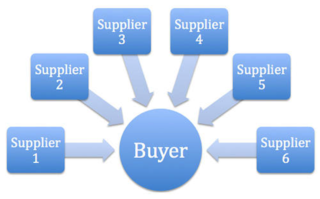
Back مزاد عكسي Arabic Търгове с обратно наддаване Bulgarian Auftragsauktion German Subasta inversa Spanish مزایده معکوس Persian מכרז הפוך HE Fordított aukció Hungarian リバースオークション Japanese Inkoopveiling Dutch Omvendt auksjon NB
This article is written like a personal reflection, personal essay, or argumentative essay that states a Wikipedia editor's personal feelings or presents an original argument about a topic. (October 2011) |

A reverse auction (also known as buyer-determined auction or procurement auction) is a type of auction in which the traditional roles of buyer and seller are reversed.[1] Thus, there is one buyer and many potential sellers. In an ordinary auction also known as a forward auction, buyers compete to obtain goods or services by offering increasingly higher prices. In contrast, in a reverse auction, the sellers compete to obtain business from the buyer and prices will typically decrease as the sellers underbid each other.
A reverse auction is similar to a unique bid auction because the basic principle remains the same; however, a unique bid auction follows the traditional auction format more closely as each bid is kept confidential and one clear winner is defined after the auction finishes.
For business auctions, the term refers to a specific type of auction process (also called e-auction, sourcing event, e-sourcing or eRA, eRFP, e-RFO, e-procurement, B2B Auction). Open procurement processes, which are a form of reverse auction, have been commonly used in government procurement and in the private sector in many countries for many decades.
For consumer auctions, the term is often used to refer to sales processes that share some characteristics with auctions, but are not necessarily auctions in the traditional sense.
- ^ Chen, Rachel R.; Roundy, Robin O.; Zhang, Rachel Q.; Janakiraman, Ganesh (1 March 2005). "Efficient Auction Mechanisms for Supply Chain Procurement". Management Science. 51 (3): 467–482. doi:10.1287/mnsc.1040.0329. ISSN 0025-1909.
© MMXXIII Rich X Search. We shall prevail. All rights reserved. Rich X Search
